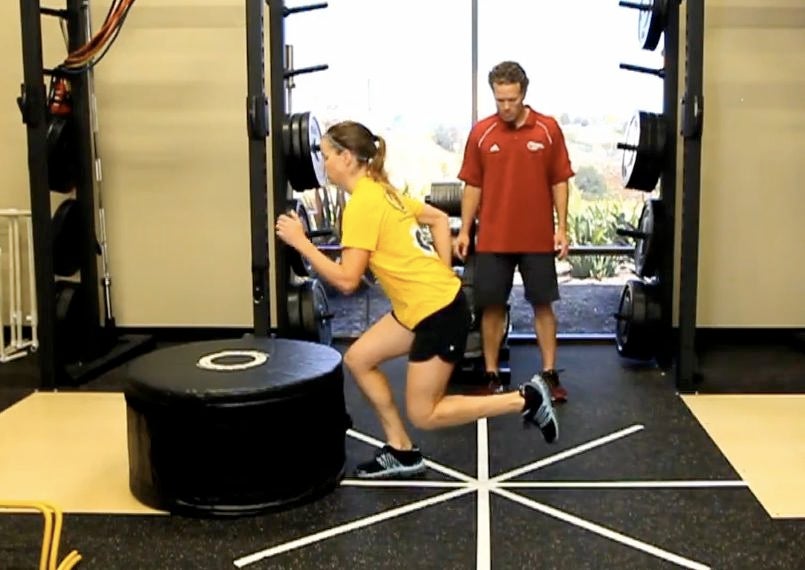Power Boost Your Brick Runs With Plyos

Athletes have long used explosive plyometric exercises to improve sprint speed and agility. Researchers have found these same exercises also improve running mechanics—specifically off the bike. Here’s how adding plyos to your training can help your transition run performance and then try the five exercises provided.
What The Research Says
Scientists at the University of Queensland have found a time-efficient way to improve running mechanics off the bike. They hand-picked a group of trained amateur triathletes who had faulty off-the-bike running mechanics. Half did plyometric training—squat jumps, bounds, hops and more—in addition to their standard triathlon training. The other half only did swim-bike-run workouts. After eight weeks, the athletes who added three sessions of explosive plyometric training a week significantly improved their brick running mechanics compared to those who only swam, biked and ran. Researchers also found plyometric training can help reduce the energy required to run, especially in athletes below the elite level. Researchers at the University of Technology, Sydney, found that trained male runners improved 3K time-trial performance and economy at speeds ranging from 6-minute/mile pace up to 8:20 pace by adding a plyometric routine to their standard training. The scientists didn’t, however, find changes to their fitness, implying the plyometric training was responsible for their improvement. Another study, this one conducted at The University of Texas at Tyler, also found that six weeks of plyo training improved running economy in amateur distance runners.
RELATED VIDEO: What Are Plyometrics?
Some Guidelines
» If you’re more than eight weeks out from your main race, you can safely do plyos twice a week. If you’re in the middle of your season, don’t do more than one session per week, and never do more than 120–150 reps of jumping.
» “You should never do just plyometrics,” says Bryan Hill, co-owner and physical therapist at San Diego’s Rehab United. Plyos should be integrated into a larger strength workout. “Kind of like a strength-plyo-strength sandwich.”
» Always warm up beforehand. “It’s a lot of stress on the muscles, so you have to make sure they’re ready,” Hill says. Even a quick spin on a stationary bike or 5–10 minutes of dynamic running drills will help.
» Before beginning a plyometrics routine, you should be able to squat 65 percent of your body weight, suggests Hill. “A jump is typically 6–8 times your body weight, so if you’re doing an activity that uses that much force, you need to be able to show you can control it.”
RELATED VIDEO: Introduction To Plyometrics
Plan Your Workout
» If you’re the type to fall apart 10 miles into a half-marathon, go for endurance. Do each exercise as many times as possible for 1 minute. The following week, increase it to 90 seconds, then two minutes. Do 2–3 rounds total.
» If it’s power or hill crushing you’re after, focus on quality reps instead of time. Do 5–10 with perfect form and great height and depth, for 2–3 rounds total. Add five reps per week.
Squat Jump
Start standing with feet shoulder-width apart. Squat down low and explode up as high as possible. Land softly back into a squat to start the next rep.
Tip: The base of many plyometric exercises is a squat to load the muscles. Proper form is key. Don’t lean too far forward—sit back like you would in a chair.
See a video demonstration of this exercise here.
Box Jump
Start with feet in a squat position. Lower down to a squat and explode up onto the box with a soft landing. Step down to return to start. If you’re new to box jumps, start with a 12-inch box and increase height once you’re comfortable.
See a video demonstration of this exercise here.
Scissor Jump
Start with feet in a lunge stance, one foot in front, with the back heel lifted off the ground. Lower into a lunge and drive up, switching legs mid-air.
Tip: You may be able to identify muscle imbalances or deficiencies if it feels tighter or less stable on one side.
See a video demonstration of this exercise here.
Lunge Hop
Start on both feet as if you’re doing a squat. Jump forward on just the left leg, landing with a bent knee and right arm in front to mimic running. Jump back to start and switch to right leg in front. Be careful not to let your knee excessively fall in.
See a video demonstration of this exercise here.
Hop
Start standing on your right leg. Hop forward, landing in a low, controlled position. Switch to left leg halfway or after designated reps. Don’t be discouraged if your balance feels off when you start. Start with a small range and work up to a greater distance.